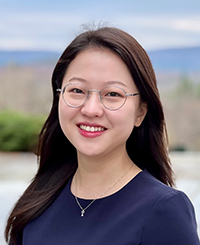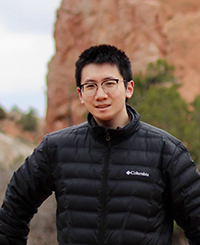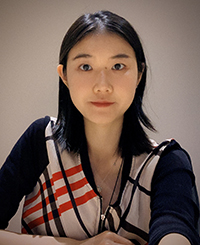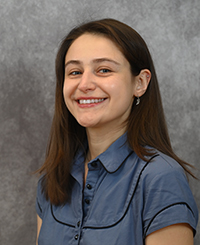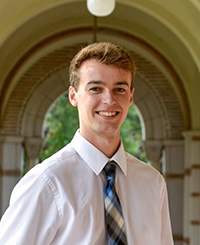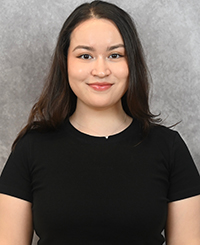Meet the fellows
This program provides up to two years of funding to the most promising PhD students.
Selected by Harvard Medical School leadership, the fellows are also enrolled in the Therapeutics Graduate Program (TGP), a new curriculum that focuses on pharmacology, toxicology, and drug discovery, emphasizing research in both HMS labs and real-world internships.
Where are you from, where did you study prior to this, and what brought you to HMS?
I was born in Queens and then moved to Staten Island, New York, where I lived for most of my childhood. I completed my undergraduate studies at Johns Hopkins University, where I majored in Chemistry. There, I conducted research on TMPRSS2-ERG fusions in prostate cancers. After graduating, I worked for 2 years in the Neal Lab at the Broad Institute, where I used CRISPR-based editing and ORF-based screening approaches to study genetic variants in cancer. I came to HMS because of the large number of labs and the collaborative nature, where I could pursue innovative biomedical research for my PhD.
How does your research hold promise for therapeutic innovation?
Despite extensive genomic characterization of glioblastoma (GBM), the current treatments are ineffective. Part of my work seeks to find certain biomarkers in GBM that can predict an effective response to drugs that inhibit cell cycle regulators. This would determine the mechanism for this drug sensitivity and help stratify patients who will respond to these therapies. Another aspect of my work seeks to find somatic/germline variants that are associated with treatment toxicity in GBM patients. Understanding how treatment toxicity occurs could help us reduce these toxicities, which is a major limitation in treating GBM.
What was your reaction when you learned you were named a Fujifilm Fellow?
I was thrilled to find out I was named a Fujifilm Fellow! The TGP has been one of my favorite communities to be a part of while in graduate school, so I was honored to be selected by them to join this prestigious cohort of students. I am grateful to Fujifilm and the TGP for creating this program, and I am excited to continue my PhD research with this support!
Where are you from, where did you study prior to this, and what brought you to HMS?
I am originally from Seoul, South Korea. I completed my undergraduate studies in Chemistry and Mathematics at Amherst College. I worked in Dr. Anthony Bishop’s lab on the discovery of small-molecule inhibitors targeting the protein tyrosine phosphatase SHP2. I later participated in the BCMP Summer Scholars Program at Harvard Medical School, where I explored the catalytic mechanism of the E3 ligase NEDD4 in Dr. Phil Cole’s lab. My experiences at Amherst and Harvard inspired me to pursue a PhD in Chemical Biology and join the Cole lab to further study NEDD4 and identify novel therapeutic strategies.
How does your research hold promise for therapeutic innovation?
My research focuses on the development of a selective inhibitor of the E3 ubiquitin ligase NEDD4. NEDD4 plays a critical role in regulating the levels of protein substrates involved in cancer, making it a compelling therapeutic target. To date, no potent and selective inhibitor of NEDD4 has been reported. The development of such a molecule could have innovative implications in both the lab and the clinic. As a chemical probe, it would allow us to investigate the fundamental biology of NEDD4, while its evaluation in relevant cancer cell lines could help validate NEDD4 as a drug target and potentially guide the development of novel anti-cancer therapies.
What was your reaction when you learned you were named a Fujifilm Fellow?
I was surprised and deeply honored to be selected as a Fujifilm Fellow. It has been an inspiring and exciting journey to be part of the TGP program, and I am truly grateful for the encouragement, support, and opportunities it has provided throughout my graduate training.
Where are you from, where did you study prior to this, and what brought you to HMS?
I grew up in Chengdu, China, and earned my bachelor’s degree in integrated science at Peking University. During my undergraduate research, I applied physical theory and deep learning to study signal transduction in the innate immune system and microbiome self-replication. I chose to join the SSQB program at HMS for its interdisciplinary approach and strong ties to medical research.
How does your research hold promise for therapeutic innovation?
Microtubule drugs, such as taxanes, are cornerstone chemotherapeutics, yet their mechanisms in patients remain poorly understood. I am investigating this from both PK and PD perspectives. My work has uncovered a unique PK property of microtubule drugs that may extend to other therapeutics. I am also developing in vitro models that better mimic in vivo conditions to help elucidate their mechanisms.
What was your reaction when you learned you were named a Fujifilm Fellow?
I am grateful and surprised to learn that I was named a Fujifilm Fellow. I look forward to contributing to the community in the future.
Where are you from, where did you study prior to this, and what brought you to HMS?
I am from a northeastern province in China with similar weather to Boston. I finished my master's degree at Harvard Chan School of Public Health and later worked at the Broad Institute for two years as a computational associate. HMS has always been my inspiring neighbor community since starting my master’s and I have been enjoying the Greater Boston area.
How does your research hold promise for therapeutic innovation?
Resolving the molecular mechanisms driving tumor evolution, transformation, and cancer progression will uncover tumor-specific biomarkers, vulnerabilities, and advance mechanism-of-action-based clinical strategies.
What was your reaction when you learned you were named a Fujifilm Fellow?
I felt stoked, honored, excited about engaging more with the community and grateful for the generous support.
Where are you from, where did you study prior to this, and what brought you to HMS?
I was born and raised in Szczecin, Poland, before moving to Chicago, Illinois, in 2013. I earned my undergraduate degree in Biochemistry and Hispanic Studies from Trinity College (Hartford, Connecticut) in 2019. Prior to joining the BBS program at HMS, I was an IRTA Postbac Fellow at the NIH, where I studied protein factors involved in mobilizing LINE-1 retrotransposons to their genomic integration sites. This experience sparked my interest in molecular biology, which is why I am at HMS today pursuing my PhD.
How does your research hold promise for therapeutic innovation?
In my dissertation work, I study gene regulation by HEXIM1, a negative regulator of RNA Polymerase II, by employing rapid protein degradation systems and nascent transcriptomic approaches. While HEXIM1 is increasingly recognized for its roles in cellular differentiation and drug response across diverse cancer contexts, its mechanistic characterization has been hindered by limitations of long-term depletion methods—an important knowledge gap that my research will address.
What was your reaction when you learned you were named a Fujifilm Fellow?
Throughout my research training, I have come to value the role that mechanistic studies play in advancing drug development, particularly in enhancing specificity and addressing the limitations of treatment strategies. Being honored by the Fujifilm Fellowship Program reassures me that my work can contribute meaningfully to therapeutic innovation, which means a lot.
Where are you from, where did you study prior to this, and what brought you to HMS?
I grew up in Southern California and Mexico and am a proud first-generation college student. I transferred from Berkeley City College to the University of California, Santa Cruz, where I earned dual degrees in Neuroscience and Cognitive Science with a focus on Evolution, and a minor in Bioinformatics. I then worked in Dr. Gerald Crabtree’s lab at Stanford studying chromatin regulation in autism. I later moved to Boston to support vector engineering research at the Broad Institute, followed by work with Dr. Konstantina Stankovic at Mass Eye and Ear on molecular mechanisms of hearing loss. These experiences deepened my fascination with molecular neuroscience and inspired me to pursue graduate training in SHBT at HMS.
How does your research hold promise for therapeutic innovation?
Hearing loss affects millions of people, yet most treatments can’t restore the complexity of natural hearing. I study how gene regulation gives rise to the different kinds of neurons that carry sound information from the ear to the brain. Understanding how these cells and their specialized synapses develop could help us identify molecular entry points for future therapies. While my work is focused on basic mechanisms, I’m motivated by the possibility that it could one day inform efforts to protect or rebuild damaged auditory circuits.
What was your reaction when you learned you were named a Fujifilm Fellow?
I was so surprised that I reread my email about three times! But I was also very grateful. Support like this affirms the importance of foundational, curiosity-driven research. It’s encouraging to know that others believe in the potential impact of our work and are investing in young scientists committed to tackling complex biological questions.
Where are you from, where did you study prior to this, and what brought you to HMS?
I am originally from Palatine, Illinois, a suburb outside of Chicago. I went to college at Rice University, where I studied cell biology and neuroscience. During this time, I was lucky to have research experiences in skin biology and cognitive neuroscience labs, which helped me develop a love for the lab, cellular biology, and the brain. I was then a research associate at NYU Langone, where I ran multiple projects in the genetics technology development space. These broad research experiences drew me to Harvard’s Biological and Biomedical PhD program, where I was able to combine my interests in the brain and cellular biology with a desire to help people by joining the Young-Pearse lab, where we study Alzheimer’s disease.
How does your research hold promise for therapeutic innovation?
Alzheimer’s Disease is the most common form of dementia and is estimated to affect nearly 50 million people worldwide, with this number expected to grow in the coming decades. This is especially relevant for females who have twice the likelihood of having AD during their lifetime. My project aims to utilize human iPSC models to better understand how the XX and XY chromosome complements may play a role in the difference between males and females. Understanding this biology may illuminate novel targets for therapeutic intervention and will be crucial to better inform future clinical studies.
What was your reaction when you learned you were named a Fujifilm Fellow?
I was surprised and deeply honored when I learned that I was named a Fujifilm Fellow. I have seen a lot of other graduate students that I highly respect earn this fellowship, and so to be nominated myself was rewarding and inspiring. I am incredibly excited to be a Fujifilm Fellow and the opportunities it will provide me to continue my work.
Where are you from, where did you study prior to this, and what brought you to HMS?
I’m originally from Urumqi, the capital of Xinjiang, China, and came to the U.S. for college. I completed my undergraduate studies in biological sciences and bioinformatics at the University of California, Santa Cruz. After that, I spent two years conducting translational research in pediatric leukemia at UCSF, working in the Loh and Stieglitz labs. During that time, I developed a strong passion for cancer research and a commitment to improving patient outcomes, which ultimately led me to pursue my PhD at HMS.
How does your research hold promise for therapeutic innovation?
By studying how cells within the tumor microenvironment change their transcriptional profiles, cellular states, and interactions in response to immune pressure, my research aims to uncover how cancers develop resistance to immunotherapy. This understanding may help identify new therapeutic targets and strategies to improve treatment outcomes.
What was your reaction when you learned you were named a Fujifilm Fellow?
I was thrilled and honored to be selected as a Fujifilm Fellow, and I’m deeply grateful for the recognition. This motivates me even more to continue doing my best and to contribute meaningfully to the field.

